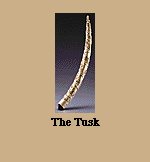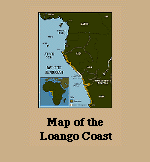 WOMAN AND CHILD FIGURE
WOMAN AND CHILD FIGUREAmong the Kongo, women are the progenitors of important lineages. They are responsible for the continuity and maintenance of the family. Kongo communities honor women by creating commemorative sculptures. The woman-and-child figure at the top of the tusk reflects this tradition.
The nursing woman is seated in a cross--legged position, similar to that of the memorial figures (phemba) found on many Kongo tombs. Her spiral headpiece is similar to others found on female figures created by artists among the Vili. This headpiece, which represents a snail's shell, has been interpreted as referring to the migration of Kongo peoples from their capital, Mbanza Kongo. It is also a sign of perpetual movement and growth. Such a headpiece is not found on sculptures of neighboring groups. She also bears what appear to be ritual markings on her face and parts of her body.
On the back of the woman and child is a rectangle within which are several pinwheel motifs--variations on the Kongo sign of the cosmos. These designs mark the points from the rising of the sun, to noon, to Mpemba (land of the dead), and back. << DOG




RETURN TO EXHIBITIONS
Credits, Rights and Reproductions, and Comments
NMAfA Home